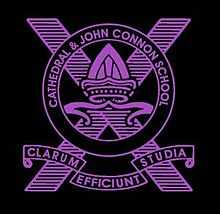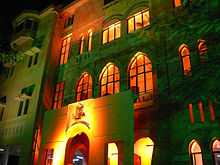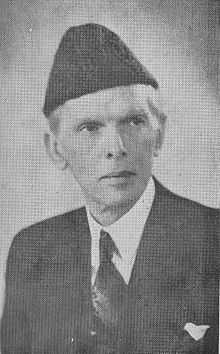The Cathedral & John Connon School
| The Cathedral & John Connon School | |
|---|---|
 'Clarum Efficiunt Studia' ('Studies Maketh Famous') | |
| Location | |
|
Mumbai, Maharashtra India | |
| Information | |
| Type | Private school |
| Established | 1860 |
| Locale | Fort, Mumbai |
| Principal | Meera Isaacs |
| Vice Principal (Senior) | Jyotsna Mayadas,Nalini Samuel |
| Grades | Lower 1 - 12 |
| Number of students | 2000 |
| School colour(s) | Purple and black |
| Athletics | DRO, MSSA, Anglo-Scottish |
| Houses |
(in alphabetical order) Barham Palmer Savage Wilson |
| Website | cathedral-school.com |


The Cathedral & John Connon School is a co-educational, private school located in Mumbai, Maharashtra.[1] It has been commended as one of the best schools in India,[2] with one of the most distinguished alumni.[3] A Hindustan Times report of 2013 named it as one of the top schools offering ICSE and ISC.[4]
The school recently celebrated the sesquicentennial anniversary of its founding.
History
In 1860 Bishop Harding and the Cathedral Chaplain opened a grammar school within the walled city of Bombay which, along with a smaller establishment for girls, were the first of many strands that have joined to form the Cathedral and John Connon School.[5][6]
A Choir School, established with the objective of providing choristers for the St. Thomas Cathedral, Mumbai, the first Anglican Church in Mumbai was founded in October, 1875. Meanwhile The Bombay Scottish Education Society was founded in 1866. The society put up a building on the Esplanade, and named it for Mr John Connon (then Chief Registrar of Bombay).
In 1878 a high school in Byculla, set up by the Bombay Diocesan Society, was merged with the Choir School to form the Cathedral High School. The present Senior School building, a blend of Indian and Gothic architecture, was erected in 1896. A girls' school had been started in 1880.
In 1922, in a public meeting held at the Town Hall, the present Asiatic Society of Bombay library, a suggestion was put forward by the principal of the Cathedral Boys' School for the Cathedral Schools and the Scottish School to work together, instead of competing, and thus the Anglo-Scottish Education Society was conceived. The schools were re-organized into the Cathedral Boys' School, the Cathedral Girls' School, and the John Connon School.
In the 1960s co-education was still viewed with trepidation, and when in 1965, the Principal, Rev. Ridding, stated that the only way to solve the financial and logistical problems of the school was to make it co-educational, some people felt so strongly about it that they went to court to thwart the school's plans. Justice Lentin, a man famous for his courageous judgments, pronounced that the school had every right to merge if it so desired. The merger proceeded smoothly.
Today the old boys' school is the Senior School; the old girls' school is the Middle School; and the John Connon School is the Junior School. The Infant School, located at Malabar Hill, was set up in 1965.[7]
Cathedral has opened a residential branch in Lonavala, The Cathedral Vidya School.
Academics and curriculum
The Cathedral & John Connon School is affiliated with the Council for the Indian School Certificate Examinations[8](CISCE), and its students appear for the Council's ISC (Grade 12) and ICSE (Grade 10) examinations. English is the medium of instruction. Hindi is taught as a second language and Marathi or Sanskrit are taught as third languages. Examinations are held at the end of every school term. The school's students have performed well at the ICSE and ISC examinations and the school has maintained a 100% pass-rate.
College Board's Advanced Placement program has been conducted in the school since June, 2004. Talented students, who would otherwise be uninterested in a mainstream classroom, are offered the chance to pursue accelerated learning (college-level) courses in subjects including English, Calculus (AB and BC), Physics, Biology, Computers, World History, Chemistry and Economics.[9] The school is the only AP Examination Center in Western India.
For the ISC course (consisting of grades 11 and 12) the school divided its student body into three streams: Commerce, Science, and the Humanities. However, as of 2008 this is no longer required and students now have the option of either choosing a particular stream or choosing subjects from different streams.
Students achieving distinctions (above 80% per term in Senior School) throughout the year become eligible for the Honours Prize for that year. Those who achieve fifteen points on a complicated scoring system, at any time after Grade 8, are awarded the Scholar's Badge. There are rarely more than three recipients in any given year.[6]

Cathedral Model United Nations (Symposium)
The Cathedral Model United Nations is run entirely by the school's student body over a period of three days, where students assume the roles of delegates representing countries. They form committees and debate on topics of global importance.[10] From a start in 1996 - the first CMUN had only one committee (Asia and Pacific Council), it has grown into an event with over 700 delegates attending.[11] CMUN 2007 was the first to have delegates from outside Mumbai. Schools like Mayo College, La Martiniere Calcutta, Doon School, and others attended the conference. 2011 featured the first international delegates from Rato Bangala School from Nepal and Aitchinson College, Pakistan. It is a highly selective invitation only event held at the Trident, Nariman Point. The fact that sets it apart from other conferences is that it is a student run event. The school has a notable policy of minimal interference which contributes to its appeal.
House system
There are four houses in the school - Barham, Palmer, Savage and Wilson - named after four founders of the school i.e. the founders of the joint venture of the Cathedral School and the John Connon School. (Original names: Canon Barham, Bishop Palmer, Arthur Savage, Percival Wilson). Students are distributed between these houses, and each is headed by a House Master/Mistress (selected from among the teaching staff). House Captains are selected from the 12th standard to lead each of the houses. The objective of the House System is to foster a sense of collective responsibility and solidarity among students. The House System serves as the center of school life, with students from the houses competing at sports, games and other co-curricular activities, primarily divided into 2 categories- Cultural and Sports which include a plethora of activities.[12]
School choir and band
The school choir dates back to the time when the school had its genesis as a choir school providing choristers to the St. Thomas' Cathedral. The Founders' Day Service and the Christmas Carol Service are the two most important events for the Choir. The choir's repertoire includes hymns, sacred classics, as well as secular music.
A school band is formed from the students. Tryouts for the school band are held once a year. The band plays rock-and-roll inspired music. It performs at the School Music festival, and at music festivals held across schools and colleges in Mumbai.
School motto
The school's motto is Clarum Efficiunt Studia translated as Studies Maketh Famous. This motto was adopted by Thomas Arthur Savage, Headmaster of the school, from Bacon's essay on “Studies”.
Studies serve for delight, for ornament and for ability…….. the general counsels and the plots and marshalling of affairs comes best from those that are learned.
School badge
In 1923 the Cathedral Schools and the Scottish School were amalgamated to form The Anglo-Scottish Education Society. Miss Whitfield, the Principal of the Girls' School, wanted a badge which was representative of both elements of the Society: Anglican and Scottish. A badge was designed in which the Bishop's Mitre represented the Anglican side, while the Scottish neighbours were symbolised by the white diagonal cross of St. Andrew.
Notable alumni
- Muhammad Ali Jinnah: founder of Islamic Republic of Pakistan.
- Ratan Tata: Industrialist and head of the Tata Group
- Cyrus Pallonji Mistry:Chairman, Tata Sons
- Rahul Bajaj: Industrialist and head of various Bajaj Group companies
- Rajdeep Sardesai: Indian Journalist & political commentator with NDTV
- Zulfiqar Ali Bhutto: former Foreign Minister, President and Prime Minister of Pakistan
- Karisma Kapoor: Bollywood actress
- Fareed Zakaria: journalist and author
- Homi Bhabha: scientist
- J.R.D Tata: industrialist,former chairman of Tata Group,known as Father of Civil aviation in India
- Milind Murli Deora: Member of Parliament
- Mukul Deora: film producer, musician
- Salman Rushdie: novelist and essayist, 1981 Booker Prize winner
- Yusuf Hamied: scientist, industrialist, philanthropist
- Siddhartha Basu: television director-producer[13]
- Arundhati Ghosh: national-level cricketer
- Jehangir Sabavala, Indian painter [14]
- Kiran Desai: 2006 Booker Prize winner
- Khalid Mohamed: film director and critic[15]
- Homi Adajania: film director
- Arundhati Ghose: foreign diplomat, head of the Indian delegation for the Comprehensive Nuclear-Test-Ban Treaty (CTBT) negotiations in Geneva in 1996.
- Sanjay Ghose: rural management, community health, rural development media
- Amisha Patel: Bollywood actress
- Fali R Singara: Popular Mumbai Radio Jockey
- Ashim Ahluwalia: National Award-winning filmmaker
- Geeta Anand: 2003 Pulitzer Prize-winning journalist
- Ashutosh Phatak: composer, musician
- Firdaus Kharas: social entrepreneur and media producer
- Vikram Gandhi: former Vice-Chairman of Credit Suisse
- Ehsaan Noorani: composer musician blues guitarist
- Pamela Ballantine: Social Activist. Awarded a MBE in 2000 by Queen Elizabeth II[16]
- Ranvir Shah, cultural activist and philanthropist [17]
See also
References
- ↑ Cfore Official website
- ↑ http://educationworldonline.net/userfiles/Day%20Schools%20League%20Table.pdf
- ↑ http://educationworldonline.net/userfiles/Parameters%20of%20Excellence.pdf
- ↑ http://www.hindustantimes.com/india-news/mumbai/three-mumbai-schools-among-top-50-offering-isc-icse/article1-1097433.aspx
- ↑ Adapted from the 125th Anniversary Souvenir
- ↑ 6.0 6.1 Adapted from the School Diary
- ↑ Welcome to The Cathedral and John Connon Alumni Association
- ↑ CISCE.ORG
- ↑ Advanced Placement
- ↑ School Profile
- ↑ "Model UNs a hit with schools". The Times of India. Aug 23, 2011.
- ↑ Welcome to The Cathedral and John Connon Alumni Association
- ↑ Board of Directors BIG Synergy.
- ↑ "Jehangir Sabavala: A painter & gentleman bows out". The Times of India. Sep 3, 2011.
- ↑ Khalid Mohamed (Sep 3, 2011). "The timeless poster boy of Hindi cinema". Asian Age.
- ↑ Queens birthday honour list in 2000
- ↑ Muthalaly, Shonali (October 30, 2009). "Best of three worlds". The Hindu. Retrieved 2014-02-24.
External links
Coordinates: 18°56′10″N 72°49′58″E / 18.936178°N 72.832825°E